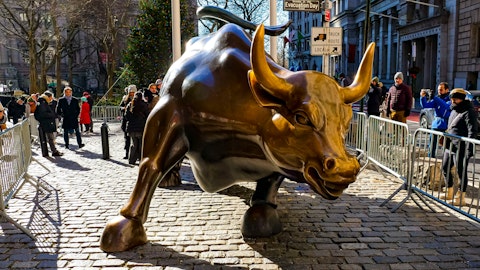The talk of a potential AI bubble is prevailing on Wall Street as investors await big tech earnings. Some analysts believe the promise of AI is huge when it comes to productivity gains and spending on the technology is justified. Jon Gray, Blackstone president and COO, talked about AI investments during a latest program on CNBC and said that his company’s AI investments are long term and backed by solid plans:
“We’re very focused on who our counterparty is and the length of the leases we signed. We’re not building these things speculatively. These are not condos in Miami or Dubai during a boom period. We have 15 to 20-year leases with the biggest companies in the world who have market caps of a trillion to 4 trillion dollars. So this to us seems like a very sensible way to play this very large investment theme,” Gray said.
The $9 Trillion Opportunity
Gray said that AI skeptics should think about why companies are investing heavily in the technology. He believes we are already seeing the benefits of AI and it can help us drive trillions in productivity gains.
“The AI which gets a lot of bubble talk, it’s worth thinking about why people are investing this much capital. We are beginning to see now some really powerful examples — productivity in coding, in customer engagement, on the legal side, in the content area. And if you think about what’s happening, it’s a huge investment boom in chips and data centers and power which will enable this big productivity boom. And if you think about the numbers involved, labor costs globally are $60 trillion. If this technology makes companies 15% more efficient, that’s $9 trillion of annual productivity gains. That means a lot of value created that justifies a lot of this capital spend.”
READ ALSO: 7 Best Stocks to Buy For Long-Term and 8 Cheap Jim Cramer Stocks to Invest In.

Source: Pexels
Why are we interested in the stocks that hedge funds pile into? The reason is simple: our research has shown that we can outperform the market by imitating the top stock picks of the best hedge funds. Our quarterly newsletter’s strategy selects 14 small-cap and large-cap stocks every quarter and has returned 427.7% since May 2014, beating its benchmark by 264 percentage points (see more details here).
10. Ishares US Equity Factor Rotation Active ETF (NYSEARCA:DYNF)
Number of Hedge Funds Investors: N/A
Jay Jacobs, U.S. Head of Equity ETFs at BlackRock, recently talked about the popularity of ETFs among investors and mentioned DYNF. Here is what he said:
“If you think a few things here, first is this is a global trend. We have seen a tremendous amount of ETF flows across the iShares business globally. We had a record-breaking first half of the year, record-breaking Q3 of this year. So, this is happening globally. I think secondly, you mentioned so many of the different tickers where we’re seeing flows. There’s a tremendous amount of breadth. Well, investors are looking for a couple of things. First, they’re looking for alpha. If you’re buying an actively managed ETF, oftentimes you want to beat the benchmark. DYNF has done a tremendous job of that over the last few years. But secondly, investors are looking for tax efficiency. So one of the big advantages of an ETF, particularly versus a mutual fund, is that even in very dynamic strategies like DYNF that have a lot of turnover, it can still deliver that in a very tax-efficient way, unlikely to pay out capital gains to investors.”
9. iShares US Large Cap Premium Income Active ETF (BATS:BALI)
Number of Hedge Funds Investors: N/A
Jay Jacobs, U.S. Head of Equity ETFs at BlackRock, explained in a recent program on CNBC why investors are pouring into iShares US Large Cap Premium Income Active ETF (BATS:BALI).
“But secondly, we’re seeing a lot of flows and I would anticipate this to accelerate in growth and income strategies. Think about outcome ETFs that are delivering upside potential to the S&P 500 with a significant amount of income like our iShares US Large Cap Premium Income Active ETF (BATS:BALI). In the context of following rates, we’re seeing a lot of investors both want to participate in the markets as well as get more yield from equities”
8. iShares 0-3 Month Treasury Bond ETF (NYSEARCA:SGOV)
Number of Hedge Funds Investors: N/A
Jay Jacobs, U.S. Head of Equity ETFs at BlackRock, explained in a recent program on CNBC why he likes SGOV.
“Well, a lot of investors are looking to get yield and they’re not necessarily getting that through holding cash in a brokerage account. So, you’ve seen a lot of investors move into SGOV, our short-term government bond ETF, just to capture that yield that government bonds are paying. There’s still $7 trillion sitting on the sidelines in money market funds. And I think a lot of that could come into the ETF industry over the next several months and years as investors want to participate in continuing markets.”
7. iShares Core S&P Small-Cap ETF (NYSEARCA:IJR)
Number of Hedge Funds Investors: 22
Bill Baruch, founder and President of both Blue Line Capital and Blue Line Futures, said in a recent program on CNBC that he was investing in IJR. Here is why:
“So the SPY and the iShares Core S&P Small-Cap ETF (NYSEARCA:IJR) they sold off pretty sharply on Friday. I was really surprised to not see any follow-through to start this week response against the 50-day moving average. And then we had Fed Chair Powell on Tuesday who comes in and talks about an endgame to QT. So I think right there you saw the Russell 2000 respond. The iShares Core S&P Small-Cap ETF (NYSEARCA:IJR) is a little a little more slimmer of a of an index and so we leaned into that potentially on the week you have a breakout in in the small caps.”
6. Oklo Inc (NYSE:OKLO)
Number of Hedge Funds Investors: 36
CNBC’s Guy Adami recently commented on Oklo Inc (NYSE:OKLO) rising to new highs and reversing sharply. The analyst recommended Oklo Inc (NYSE:OKLO) investors take some profits off the table:
“New all-time high closed on the lows, one and a half to two times normal volume, having had a parabolic move to the upside. Yeah. You got to take this one and say if I’ve been longing this stock, if I’ve enjoyed this, you got to move your feet here. You have to do something. And that something is either sell half, third quarter, whatever it is, but you got to move your feet.”
5. Kimberly-Clark Corp (NASDAQ:KMB)
Number of Hedge Funds Investors: 42
Jenny Harrington, CEO and Portfolio Manager at Gilman Hill Asset Management, said in a recent program on CNBC that KMB is currently one of her favorite stocks. Here is why:
“The reason I like it is because I don’t like anything else. I don’t like cash. I don’t like bonds. I don’t like areas of the market that have done well. I don’t like stocks that are already up 25 or 50%. So, what you’ve got with Kimberly-Clark Corp (NASDAQ:KMB), which by the way, we all know what Kimberly does. They make Kleenex, Huggies, toilet paper, they make Scott’s toilet paper, and then the, you know, higher-end Cottonelle toilet paper. But the stock is down 20% over the last 52 weeks, 9% year-to-date, trades at about 16 and a half times earnings, has a 4.2% dividend yield, and come May, people are going to keep using their products. There’s just a huge amount of economic insensitivity. So, this is where I want to hide out in the fourth quarter. Oh, and by the way, even though I don’t like anything else.”
4. Walmart Inc (NYSE:WMT)
Number of Hedge Funds Investors: 105
Tim Seymour, the founder and Chief Investment Officer of Seymour Asset Management, talked about WMT in a recent program and said the stock has potential for multiple expansion in the future. Here is what he said:
“There’s there’s no question I guess the theme of tonight is rerating and while we talked about that with Walmart Inc (NYSE:WMT) with a north of 30 multiple most of this year and could it support it. Given the environment we have people will ask questions later. They’re there. You know, people people will take this multiple higher and I think you probably should.”
Walmart Inc (NYSE:WMT) recently said it is partnering with OpenAI to use AI in retail channels to allow customers to shop online at Walmart Inc (NYSE:WMT) through ChatGPT using Instant Checkout.
Jefferies analyst Corey Tarlowe said the partnership would help Walmart Inc (NYSE:WMT) gain more mind and wallet share from customers, and support sales and margin growth.
3. SPDR S&P 500 ETF Trust (NYSEARCA:SPY)
Number of Hedge Funds Investors: 109
Bill Baruch, founder and President of both Blue Line Capital and Blue Line Futures, said in a recent program on CNBC that he was investing in SPY. Here’s why:
“So the SPDR S&P 500 ETF Trust (NYSEARCA:SPY) and the IJR they sold off pretty sharply on Friday. I was really surprised to not see any follow-through to start this week response against the 50-day moving average. And then we had Fed Chair Powell on Tuesday who comes in and talks about an endgame to QT. So I think right there you saw the Russell 2000 respond. And then as for the S&P we’re talking about valuations at the desk. If you look at relative valuations which 40% of the S&P is eight names. If you look at relative valuations the MAG 7 is right in the middle of the range it’s been over the last decade. So, I don’t think it’s it’s overvalued to in to some regard, but if we respond against the 50-day moving average as we have and we’re going to rally potentially, I want to make sure that that ETF slice that we have in these portfolios is now fully allocated.”
2. Oracle Corp (NYSE:ORCL)
Number of Hedge Funds Investors: 124
In a recent interview with CNBC’s David Faber, Oracle Corp (NYSE:ORCL) co-CEO Mike Sicilia said the company wouldn’t be investing in AI if the business weren’t profitable. He said demand is “not the problem.”
“If we didn’t think this was going to be a wonderfully profitable business, we wouldn’t be in the business. I mean, obviously there are some upfront investments, right? If you’re going to build a brand new apartment building and you’ve got the first couple people that move in, you still have to pay for the whole building to be able to build that building. The difference is though, this building is sold out, right? So this building is sold out and people are lined up to move in. This is not a Field of Dreams scenario where we’re building things hoping people will come. Demand is not the problem. Supply still remains the problem.”
According to some media reports, nearly two-thirds of the company’s roughly $500 billion backlog is tied to OpenAI, highlighting serious customer concentration risks. Under the agreement between the companies, OpenAI will reportedly rent cloud infrastructure through Oracle Corp (NYSE:ORCL) Cloud Infrastructure (OCI), with costs estimated at about $60 billion annually. To finance this deal, OpenAI plans to rely on equity funding, echoing the venture capital-driven growth seen during the dot-com era.
Oracle Corp (NYSE:ORCL) shares recently fell after a media report that said the company’s AI Cloud business margins are low. However, the company said in its latest analyst day that its AI infrastructure projects are projected to generate gross margins ranging from 30% to 40%.
Headwaters Capital Management stated the following regarding Oracle Corporation (NYSE:ORCL) in its third quarter 2025 investor letter:
“The catalyst for the September AI trade was Oracle Corporation’s (NYSE:ORCL) announcement of a 5-year contract with OpenAI for $300B (implying annual contract value of $60B) to host the company’s LLMs at Oracle data centers beginning in 2027. While the market has grown desensitized to these large headline numbers, it’s useful to step back and put these figures into context from the perspective of both the magnitude of spending and return on investment. It’s easiest to start with the amount of investment that five companies are collectively spending on AI. The table below outlines CAPEX spending by the five hyperscalers and compares it with the other 495 companies in the S&P 500. In 2026, these five hyperscaler companies are expected to spend $405B of CAPEX, nearly all of this related to AI infrastructure build.
In terms of the economics around this investment, details have emerged from the Oracle-OpenAI announcement that can help investors begin to untangle the economics of these contracts. It’s easiest to unpack this from the perspective of each of the players involved.
Committed to spending $60B annually with Oracle to host the Company’s LLMs. This annual expense represents the Company’s cost of goods sold for running LLMs. OpenAI is on track to generate $13B of revenue in 2025 (Source: Reuters and the Information). So just to cover the cost of operating their LLMs on this single contract, OpenAI needs revenue to grow 4.6x in 2 years, or a +115% CAGR over the next 2 years. This is a single contract for hosting services. OpenAI has numerous other hosting contracts, implying that the company needs revenue to significantly exceed $60B just to cover the company’s total cost of goods sold…” (Click here to read the full text)
1. Meta Platforms Inc (NASDAQ:META)
Number of Hedge Funds Investors: 260
Karen Firestone, the Co-founder and Chair Emerita of Aureus Asset Management, said in a recent program on CNBC that she trimmed Meta Platforms. Here is why:
“Most of the reason that we trim them is because they were so large as positions in our portfolios. So these are stocks that we’ve been overweight for years and that overweight has expanded and expanded, and when you’re running a portfolio that’s diversified and you have positions that are close to 10%, I mean they weren’t at 10% but you know, you’re getting it to the 8 and a half, 9%. It’s prudent to just reduce that when we look at just what’s happened with the market and also earnings growth is likely to slow somewhat. Still going to be decent, but we’ve had such enormous gains in earnings over the last few quarters,” Firestone said.
With daily active users of about 3.48 billion, Meta’s huge edge in the AI race is the data and user base it has access to, which is extremely useful for ads targeting and monetization.
In 2024, digital advertising accounted for about 98% of the company’s total revenue. The business is thriving for now. In the June quarter, price per ad rose 9% year over year, reflecting higher returns for advertisers and a favorable supply and demand balance for Meta.
However, an overall slowdown in digital advertising and huge spending from the company could limit the stock’s upside. Between 2014 and 2019, digital advertising rose about 20% annually, but growth is now expected to slow to 9% per year from 2025 through 2030.
Meta is expected to spend about $60 billion to $65 billion in 2025 on capital expenditures to expand its artificial intelligence infrastructure. Unlike hardware chip makers like Nvidia, companies like Meta would need to show actual results from their AI spending to unlock more shareholder value in the short term.
Macquarie Large Cap Growth Fund stated the following regarding Meta Platforms, Inc. (NASDAQ:META) in its third quarter 2025 investor letter:
“Contributing to relative performance were stocks in which the Fund holds an underweight position or no shares at all. Meta Platforms, Inc. (NASDAQ:META), parent company of Facebook, is a new but still underweight position in the portfolio. We recognize the company has quality characteristics – like its large user base and technology advantages – plus, not owning it presents risk management challenges relative to the benchmark given its significant benchmark weight. Nevertheless, we believe Meta still has valuation and quality hurdles to clear before becoming a full position, particularly providing more clarity on its use of capital.”
While we acknowledge the potential of META to grow, our conviction lies in the belief that some AI stocks hold greater promise for delivering higher returns and have limited downside risk. If you are looking for an AI stock that is more promising than META and that has 100x upside potential, check out our report about this cheapest AI stock.
READ NEXT: 20 Best AI Stocks To Buy Now and 30 Best Stocks to Buy Now According to Billionaires.
Disclosure: None. Insider Monkey focuses on uncovering the best investment ideas of hedge funds and insiders. Please subscribe to our free daily e-newsletter to get the latest investment ideas from hedge funds’ investor letters by entering your email address below.





